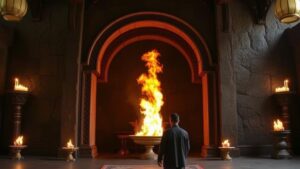Cryptozoology expeditions in the Amazon: firsthand accounts of searching for El Mono Grande.
Cryptozoology Expeditions in the Amazon: Firsthand Accounts of Searching for El Mono Grande
The Amazon rainforest, a sprawling sanctuary of biodiversity, has long been a focal point for those intrigued by the possibility of undiscovered species. Among the legendary creatures said to inhabit this verdant landscape is El Mono Grande, or the Big Monkey. Cryptozoologists–the researchers who seek to uncover the truth behind these elusive beings–have embarked on numerous expeditions in pursuit of this creature. This article delves into the stories and firsthand accounts from those who have braved the wilds of the Amazon in search of El Mono Grande.
A Brief History of El Mono Grande
El Mono Grande is described as a gigantic primate, often likened to a howler monkey but significantly larger, standing as tall as a human. legend of this creature has been passed down through generations, particularly among indigenous tribes such as the Ticuna and the Jivaro. Historical accounts date back to the 16th century, when Spanish explorers first reported sightings of a large, hairy creature in the jungles of Brazil and Peru.
Modern descriptions suggest that El Mono Grande is nearly seven feet tall and characterized by its long limbs and a howling sound that resonates through the trees. The ongoing fascination with this cryptid has led to organized expeditions in hopes of capturing definitive evidence of its existence.
Throughout the years, numerous expeditions have ventured into the depths of the Amazon rainforest in search of El Mono Grande. Two notable explorations took place in 2005 and 2019, attracting cryptozoologists, wildlife enthusiasts, and amateur adventurers.
- Expedition 1: The 2005 Journey – Led by renowned cryptozoologist Dr. Carl Fitzgerald, this expedition embarked from Manaus, Brazil, traveling for three weeks through the dense foliage. Using a combination of infrared cameras and sound recording equipment, the team hoped to capture evidence of the elusive creature. Despite numerous nights filled with eerie howling sounds and occasional glimpses of shadowy figures, the expedition returned without concrete proof.
- Expedition 2: The 2019 Expedition – This journey, organized by a group of five researchers from different countries, focused on a smaller, unexplored area of the rainforest near the Amazon River. Utilizing drones to survey treetops and conduct audio recordings, the team gathered data on local wildlifes vocalizations. Their findings revealed that some sounds previously attributed to El Mono Grande were likely made by capuchin monkeys, but unexplainable sounds were also recorded, leaving the mystery alive.
Firsthand Accounts: Encounters and Experiences
Many participants in these expeditions have shared their personal experiences, adding to the lore surrounding El Mono Grande. For example, Dr. Fitzgerald reported an unnerving night when the team was woken by a chilling howl that seemed to circle their campsite. He described the sound as larger than life, noting an almost primal quality to it that left the team both terrified and exhilarated.
In another account, expedition member Sarah Turner recounted her experience when she thought she spotted a large, upright figure through the dense underbrush. My heart raced, she said. For a moment, I thought it was El Mono Grande, but as I got closer, I realized it was a group of howler monkeys. This candid observation highlights the challenges researchers face in distinguishing between known species and the unknown.
Engagement with Local Communities
Integral to any expedition is the collaboration with local populations who possess invaluable knowledge of the region. Communities surrounding the Amazon have shared stories of El Mono Grande for centuries. e narratives often offer clues to the creatures behavior and habitat.
In 2020, a collaborative expedition in partnership with the Ticuna community resulted in a different perspective. Local guides led the researchers to specific forest areas, sharing insights on anecdotal occurrences rather than concrete evidence. The stories have truth, one local elder explained. Whether the big monkey exists or not, it is a reminder of the connection we have to the forest. This sentiment reflects the importance of respecting indigenous knowledge while pursuing scientific inquiry.
Conclusion: The Pursuit Continues
The search for El Mono Grande remains a tantalizing puzzle, blending the realms of science and folklore. Each expedition not only aims to uncover the myth but also contributes to our understanding of the Amazons rich biodiversity. While no definitive evidence has emerged, the allure of the unknown continues to drive these explorations.
For those inspired by the tales of cryptozoological adventures, participating in or supporting these field studies presents an actionable opportunity to engage with science, conservation, and the vast mystery of the Amazon rainforest. Whether El Mono Grande exists or not, the journey into the wild ultimately enriches our knowledge of the natural world.


